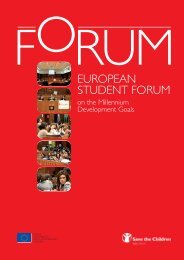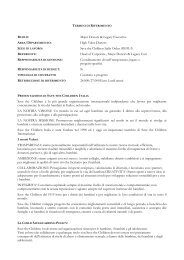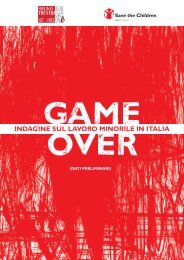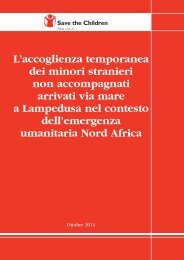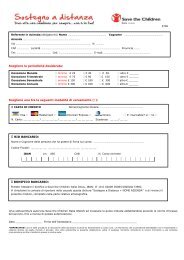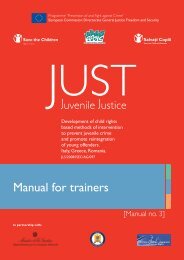IIPART<strong>FINAL</strong> <strong>REPORT</strong>Development of a Child Rights Methodology to Identify and Support Child Victims of TraffickingAlready in 1995 <strong>the</strong> UNHCR published a training module for interviewing asylum seekersincluding a specific chapter on children which is available in German.It can be concluded that <strong>the</strong>re are recommendations for standards, but up to this point no specificstandards on identification and support of victims of child trafficking have been agreed on with regardto all categories of exploitation and with validity for all different stakeholders across Germany. Thisconclusion matches <strong>the</strong> project finding that in some cities or regions cooperation works well due to<strong>the</strong> individual stakeholders involved, and in some cities or regions cooperation is very unsatisfactory.ITALYNational Legal FrameworkTwo are <strong>the</strong> main legislative instruments available in Italy dealing with trafficking in humanbeings:• Law Decree 286/98 39 on Provisions concerning Immigration and Norms on <strong>the</strong> Foreigner’sCondition and its implementation Presidential Rules Decree 394/1999: under this law, atarticle 18, a person who has suffered violence or exploitation and a person whose life is indanger can receive special protection, entering <strong>the</strong> assistance and social integration programme.Any victim has <strong>the</strong> right to receive protection and assistance, this including psychologicalsupport, health assistance, vocational training, and social integration. Any victim has <strong>the</strong> right toreceive interim care in a first reception centre and <strong>the</strong>n be transferred to a protected shelterwhere long-term protection is provided. Under this programme, any victim, be <strong>the</strong>y adult orchild, shall be given a permit to stay in Italy on humanitarian grounds for an initial period of 6months that can be fur<strong>the</strong>r extended for 1 year. The permit can be eventually converted into astudy or work permit. Two are <strong>the</strong> ways to access <strong>the</strong> programme: where <strong>the</strong> victim is detectedby law enforcement agents in <strong>the</strong> course of an investigative operation, <strong>the</strong> victim declares his/hersituation; o<strong>the</strong>rwise, <strong>the</strong> victim may simply express <strong>the</strong> will to enter <strong>the</strong> programme withouthaving <strong>the</strong> obligation to denounce his/her situation to law enforcement agents.• information to competent authorities: <strong>the</strong> Public Prosecutor in Juvenile Courts is informed of<strong>the</strong> presence of <strong>the</strong> child and his/her status;• interim protection: <strong>the</strong> child is referred to first reception centres and given food and drinksand, where necessary urgent medical assistance is provided;• in-depth interview: specialists of ei<strong>the</strong>r law enforcement agencies, NGOs or social servicesconduct <strong>the</strong> in-depth interview, ga<strong>the</strong>ring information on <strong>the</strong> story of <strong>the</strong> victim, assessingwhe<strong>the</strong>r <strong>the</strong> child is willing to receive assistance and informing <strong>the</strong> child of measures ofprotection available;• <strong>the</strong> programme of assistance and integration: after receiving <strong>the</strong> authorisation of <strong>the</strong> Judicialauthority, <strong>the</strong> programme is implemented;• assistance provided: children receive material assistance, emergency medical treatment,healthcare, education and vocational training, as well as access to counselling and information.Translation and interpreting are also provided by cultural mediators.One of <strong>the</strong> best practices of identification and support of child victims is applied in <strong>the</strong> Municipalityof Venice. Representatives of both Local Social Services and law enforcement agents participated at<strong>the</strong> seminar organised in this project (see chapter 8) and shared <strong>the</strong>ir experiences while discussing <strong>the</strong>AGIS methodology for identification and support of child victims presented in chapter 7 of thisreport. Their particular practice has already been mapped in a European project on identification andsupport of victims of trafficking 40 and <strong>the</strong>refore will not be detailed here.The practice presented above and <strong>the</strong> experience developed by stakeholders, such as <strong>the</strong> one of <strong>the</strong>Municipality of Venice, have been fed into <strong>the</strong> development of <strong>the</strong> AGIS methodology foridentification and support of child victims of trafficking. Fur<strong>the</strong>rmore, a detailed description of<strong>the</strong> measures of child protection available in Italy, as well as a presentation of identification andsupport practices that should be followed, are provided in <strong>the</strong> <strong>Italia</strong>n Protocol for identificationand support of child victims (see Part III of this Report).ROMANIA<strong>FINAL</strong> <strong>REPORT</strong>Development of a Child Rights Methodology to Identify and Support Child Victims of TraffickingIIPART4839As modified by Law189/2002.• Law 228/2003 on Measures against trafficking in persons.The law has modified articles 600, 601, 602 and 416 of <strong>the</strong> Penal code. Article 600 is aboutslavery and servitude, 601 on trafficking in human beings, 602 on <strong>the</strong> slave trade and article416 on <strong>the</strong> punishment of those involved in <strong>the</strong> crimes mentioned in <strong>the</strong> previous articles.Articles 12 and 13 of <strong>the</strong> law set up a special fund to support assistance programmes and for<strong>the</strong> creation of a special programme of assistance. Victims can receive assistance in a protectedshelter for 3 months that can be extended to 6 months.It is important to note that unaccompanied children (EU and non-EU nationals) detected in Italy,have <strong>the</strong> right to receive protection first and foremost because <strong>the</strong>y are children, thus independentlyfrom <strong>the</strong>ir status as victims of trafficking or exploitation. Upon detection, <strong>the</strong>y should accommodatedin a secure shelter and relevant authorities are informed of his/her presence (<strong>the</strong> Public Prosecutor of<strong>the</strong> <strong>Italia</strong>n Republic in <strong>the</strong> Juvenile Court). In any case, unaccompanied children can not be expelled.Practices or Methodologies for Identificationand Support of Child VictimsThe legal instruments described above provide a general framework for procedures that shouldbe followed on identification and support of child victims. None<strong>the</strong>less, procedures mayvary in different local contexts. The general framework is as follows:• coordination: law enforcement agencies (<strong>the</strong> police, Carabinieri and Guardia di Finanza),Institutions, NGOs, <strong>the</strong> judiciary, define <strong>the</strong>ir mandate and rules of cooperation;• detection of an unaccompanied child: this is done by ei<strong>the</strong>r law enforcement agents or streetunits of NGOs or <strong>the</strong> state social services;• identification: a first interview is conducted by <strong>the</strong> stakeholders who has detected <strong>the</strong> child;• if needed, when no ID document is available, an investigation on personal family and socialhistory is conducted;• <strong>the</strong> child is not a victim of trafficking: if an unaccompanied child is found not to be a victimof trafficking, he/she receives protection because he/she is a child;National Legal FrameworkRomania has two relevant laws developed nationally to address <strong>the</strong> crime of trafficking inpersons and also seek to protect victims of crimes.• Law no 678/2001: on preventing and combating trafficking in persons, as amended andmodified, and its subsequent Implementing Regulation adopted by Government Decision299/2003. The Law on preventing and combating trafficking in persons penalises variousforms of human trafficking and sets up <strong>the</strong> appropriate legal framework for moderninvestigative methods and <strong>the</strong>ir use in identifying trafficking actions. The Law also createsnorms for assisting and protecting <strong>the</strong> victims and <strong>the</strong>ir families, as well as providing forwitness protection.• Law no 211/2004: came into force in January 2005 and introduced several provisions aimingto protect victims of crime. The law defines four categories of measures directly targeting <strong>the</strong>victims of crime and <strong>the</strong>ir needs: information for victims on <strong>the</strong>ir rights; psychologicalassistance; legal assistance free of charge; and that trafficking victims can enjoy <strong>the</strong> same rightsif s/he meets <strong>the</strong> legal requirements provided.Practices or Methodologies for Identificationand Support of Child VictimsThe procedures presented below are applicable in cases of internal and international childtrafficking and in cases of exploitation. The stakeholders involved are: <strong>the</strong> Border Police GeneralInspectorate, <strong>the</strong> General Direction for Social Assistance and Child Protection, <strong>the</strong> National Authorityfor <strong>Children</strong>’s Rights Protection (NACRP), Transit Centres, Emergency Care Centres, <strong>the</strong> CountyGeneral Directorate for Social Assistance and Child Protection, <strong>the</strong> National Authority for <strong>Children</strong>’sRights Protection and <strong>the</strong> National Agency against Trafficking in Persons (ANIPT).However, in cases of internal trafficking, <strong>the</strong>re is no involvement of <strong>the</strong> Border Police.40See Resource Book forLaw Enforcement Officerson Good Practices inCombating ChildTrafficking, pp. 163-173,March 2006, producedwithin <strong>the</strong> project“ComprehensiveTraining for LawEnforcement AuthoritiesResponsible fortrafficking in<strong>Children</strong>/Minors”implemented under <strong>the</strong>AGIS Programme 2005.49
IIPART50<strong>FINAL</strong> <strong>REPORT</strong>Development of a Child Rights Methodology to Identify and Support Child Victims of TraffickingBorder Police General Inspectorate:• notifies <strong>the</strong> appropriate border point of <strong>the</strong> child’s return and his/her identity to facilitate <strong>the</strong>child legal guardians’ access to <strong>the</strong> child;• notifies <strong>the</strong> nearest police precinct of <strong>the</strong> child’s identity (police precinct near <strong>the</strong> Counsellingand Assistance Centre);• designated border police officers inform <strong>the</strong> child of <strong>the</strong>ir right, as a victim, to file a complaintagainst <strong>the</strong> persons which trafficked <strong>the</strong>m and of <strong>the</strong>ir role in <strong>the</strong> legal proceedings (<strong>the</strong> childand <strong>the</strong> officer in charge sign affidavits);• if <strong>the</strong> victim does not speak Romanian, a translator should provide assistance;• designated officers file <strong>the</strong> victim’s statement on <strong>the</strong> events, <strong>the</strong> perpetrator and o<strong>the</strong>r detailsrelevant to <strong>the</strong> law enforcement agencies (taking into account <strong>the</strong> victim’s state of mind andphysical condition);• at <strong>the</strong> victim’s request, she/he will be placed in an assistance and counselling centre, ei<strong>the</strong>r onenominated by him/her or <strong>the</strong> nearest to his/her home town, taking into account <strong>the</strong> vacancylevel of <strong>the</strong> centre;• The child’s legal guardian or o<strong>the</strong>r designated person will take <strong>the</strong> child into custody andaccompany him/her to his/her area of residence or to a specialised centre for unaccompaniedchildren and trafficking victims. The centre is subordinate ei<strong>the</strong>r to <strong>the</strong> General Directorate forSocial Assistance and Child Protection or to an authorised private institution.General Direction for Social Assistance and Child Protection:• nominates a representative which will accompany <strong>the</strong> child to his/hers area of residence or to aspecialised centre for unaccompanied children and for trafficking victims in his/her area ofresidence or in one of <strong>the</strong> border counties if <strong>the</strong> child’s residence is unknown (to ensure that <strong>the</strong>child is taken into custody, she/he has a legal representative and is accompanied by an adult);• according to <strong>the</strong> law, <strong>the</strong> general director or <strong>the</strong> executive director of <strong>the</strong> General Directoratefor Social Assistance and Child Protection agrees upon <strong>the</strong> appropriate emergency protectionmeasures of <strong>the</strong> child (who is accompanied to <strong>the</strong> centre);• if this is not possible, <strong>the</strong> director must immediately notify <strong>the</strong> National Authority for <strong>the</strong>Protection of Child’s Rights, which will delegate <strong>the</strong>se responsibilities to <strong>the</strong> Bucharest District2 General Direction for Social Assistance or to <strong>the</strong> local General Directorate for SocialAssistance and Child Protection (<strong>the</strong> county where <strong>the</strong> border point is located);• <strong>the</strong> child is accompanied to <strong>the</strong> specialised centre for unaccompanied children or for traffickingvictims. These centres are under <strong>the</strong> supervision of <strong>the</strong> local General Directorates for SocialAssistance and Child Protection. There she/he will receive assistance as stipulated by <strong>the</strong> lawuntil he/she is ei<strong>the</strong>r taken by his family or by <strong>the</strong> General Directorate for Social Assistanceand child protection from his county of residence;• <strong>the</strong> local General Directorate for Social Assistance and Child Protection from <strong>the</strong> child’s area ofresidence will make all necessary arrangements for <strong>the</strong> child’s reintegration into <strong>the</strong> family (i.e.assesses <strong>the</strong> family and analyses <strong>the</strong> reintegration opportunities, solves legal issues - identity papersor o<strong>the</strong>r documents which certify <strong>the</strong> professional skills, <strong>the</strong> educational or professionalreintegration and any health problems) and monitors <strong>the</strong> case for a minimum period of 3 months.A toll-free hotline for children is available in each local General Directorate for Social Assistanceand Child Protection (GDSACP) where complaints of child abuse or trafficking can be made.National Authority for <strong>Children</strong>’s Rights Protection (NACRP):• forwards any relevant documents on <strong>the</strong> returned child’s situation to competent foreignauthorities requesting information;• observes compliance with minimum compulsory requirements of <strong>the</strong> centres (providingprotection and emergency assistance to children, victims of trafficking;• monitors <strong>the</strong> cases, jointly with <strong>the</strong> National Authority against People Trafficking.Transit CentresThe Regional and Transit Centres provide assistance in cases of sexual and labour exploitation,crime, organ harvesting, internal or external trafficking (in compliance with <strong>the</strong> minimummandatory standards for <strong>the</strong> protection and assistance of victims of trafficking in human beings).The Bucharest Pilot Centre has <strong>the</strong> responsibility for <strong>the</strong> coordination of <strong>the</strong> activity of all transitcentres, monitoring <strong>the</strong> situation of returned children and setting up a national database of casesof trafficked children.<strong>FINAL</strong> <strong>REPORT</strong>Development of a Child Rights Methodology to Identify and Support Child Victims of TraffickingA. When <strong>the</strong> child enters <strong>the</strong> country through a different border point (not Otopeni/Henri Coanda)and is taken into custody by a representative of <strong>the</strong> Transit Centre or a GDSACP representativefrom his/hers area of residence <strong>the</strong> practice followed is <strong>the</strong> following:• an employee of <strong>the</strong> Transit Centre is nominated by <strong>the</strong> local GDSACP where <strong>the</strong> child lives tomeet <strong>the</strong> child victim, represent him/her and accompany <strong>the</strong> returned child. The localGDSACP also provides <strong>the</strong> child’s personal data to <strong>the</strong> border point;• <strong>the</strong> nominated person arrives at <strong>the</strong> Border Point to take <strong>the</strong> child into custody;• border police officers immediately carry out <strong>the</strong> border procedures and <strong>the</strong> child is handed overto an adult who accompanies him/her to <strong>the</strong> Transit Centre, where she/he undergoes a medialexamination and is admitted into an assistance, protection and reintegration programme;• GDSACP’s General Director or Executive Director in <strong>the</strong> county where <strong>the</strong> Transit Centre islocated agrees upon <strong>the</strong> emergency placement of <strong>the</strong> unaccompanied child and authoriseshis/her admission to <strong>the</strong> Transit Centre;• <strong>the</strong> Transit Centre notifies <strong>the</strong> NACRP of <strong>the</strong> child’s situation and forwards relevant caseinformation to <strong>the</strong> Pilot Centre (to be entered into <strong>the</strong> national database);• according to Law 272/2004, <strong>the</strong> Transit Centre provides accommodation and specialistassistance for a period of 15 days;• if no solution for <strong>the</strong> child’s reintegration into his/her family is found during this time period,<strong>the</strong> child is admitted into a residential care institution. The child may continue to receivepsychological assistance and social protection in <strong>the</strong> Pilot Centre;• <strong>the</strong> accommodation period can be extended up to 3 months or throughout <strong>the</strong> entire trialperiod at <strong>the</strong> request of law enforcement representatives.B. When <strong>the</strong> child receives assistance at <strong>the</strong> Pilot Centre or in a Transit Centre outside his/her area ofresidence <strong>the</strong> practice followed is <strong>the</strong> following:• an employee of <strong>the</strong> Transit Centre is nominated by <strong>the</strong> local GDSACP where <strong>the</strong> child lives totake <strong>the</strong> child into custody and accompany him/her to <strong>the</strong> Centre;• <strong>the</strong> delegated person or <strong>the</strong> legal guardian accompanies <strong>the</strong> child from <strong>the</strong> Pilot or TransitCentre to his/her family or to ano<strong>the</strong>r Transit centre in his/her area of residence;• <strong>the</strong> unaccompanied child is admitted to <strong>the</strong> Transit Centre (emergency placement) or s/hebenefits of o<strong>the</strong>r protection measures, taking into account his/her situation;• <strong>the</strong> Transit Centre notifies <strong>the</strong> NACRP of <strong>the</strong> child’s situation and forwards on his/her personaldata;• <strong>the</strong> Transit Centre provides accommodation and specialised assistance for a period of 15 days,according to <strong>the</strong> law 272/2004;• if no solution for <strong>the</strong> child’s reintegration into his/her family is found during this time period,<strong>the</strong> child is admitted into a residential care institution. The child may continue to receivepsychological assistance and social protection in <strong>the</strong> Pilot Centre;• <strong>the</strong> accommodation period can be extended up to 3 months or throughout <strong>the</strong> entire trialperiod at <strong>the</strong> request of law enforcement representatives.Regional Transit Centres and Emergency Care Centres for abused/trafficked childrenThese units provide temporary support and protection to child victims, including victims ofinternal trafficking. In particular:• <strong>the</strong>y provide shelter and specialised assistance for a period of 15 days;• <strong>the</strong>y are subordinate to <strong>the</strong> local GDSACP and represent only one step of <strong>the</strong> intervention (anemergency measure);• once <strong>the</strong> child passes <strong>the</strong> medical exam, s/he is allowed to be integrated in a residential carefacility (<strong>the</strong> child’s health condition must allow for his/her integration without affecting <strong>the</strong>o<strong>the</strong>rs);• <strong>the</strong> child has no transmittable diseases: hepatitis B or C, HIV, acute tuberculosis, acute mentalor somatic diseases;• if <strong>the</strong> child is in bad health, s/he will be admitted into a children’s hospital and <strong>the</strong>n, oncehis/her condition improved, s/he is taken into custody by one of <strong>the</strong> Centres.In <strong>the</strong> Centre:• <strong>the</strong> child is provided with basic accommodation and food;• accommodation is provided taken into account <strong>the</strong> child’s age and gender;• <strong>the</strong> children are informed of <strong>the</strong> centre’s internal rules, and of <strong>the</strong>ir rights and responsibilities;IIPART51



